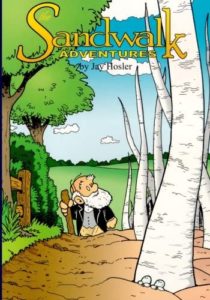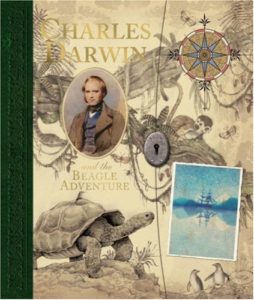Table of Contents
DISCOVERING DARWIN
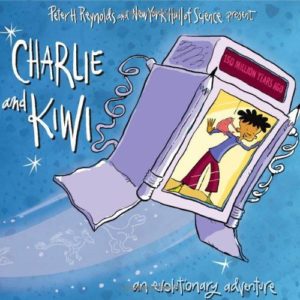
|
In the New York Hall of Science ‘s Charlie and Kiwi An Evolutionary Adventure (Atheneum Books for Young Readers, 2011), illustrated by Peter Reynolds, Charlie – with the help of his several-times-great-grandfather Charles Darwin and a Tardis-like time machine – travels back in time to learn about the evolution of the mysteriously flightless kiwi. The conclusion: “Little changes in each generation add up to BIG changes.” For ages 4-9. |
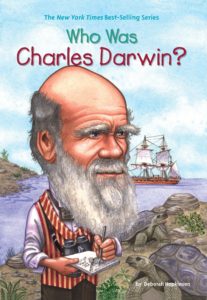
|
Deborah Hopkinson’s Who Was Charles Darwin? (Grosset & Dunlap, 2005), one of the Who Was…? children’s biography series, is a reader-friendly chapter book covering Darwin’s life from childhood through his voyage on the Beagle (he was seasick) and his revolutionary theory of evolution. For ages 7 and up. |
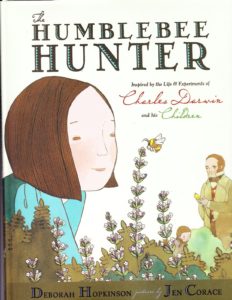
|
Deborah Hopkinson’s The Humblebee Hunter (Hyperion Books, 2010) is told from the point of view of Charles Darwin’s daughter, Etty – who, along with the rest of the Darwin children, often joined their father in his experiments with the natural world. Here Etty is unhappily trapped in the kitchen, when her father proposes “The Great Bee Experiment” – how many flowers does a humblebee visit in a minute? For ages 4-8. |
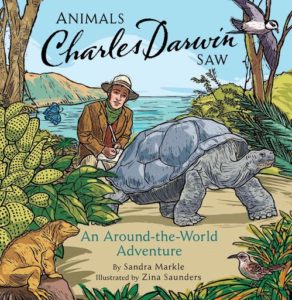
|
Sandra Markle’s Animals Charles Darwin Saw (Chronicle Books, 2009) features the creatures that influenced Darwin’s thought: beetles, flamingos, tortoises, finches. For ages 7-10. |
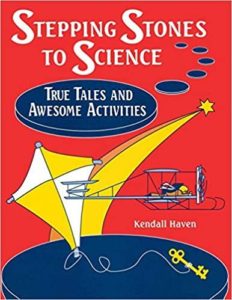
|
Kendall Haven’s Stepping Stones to Science (Libraries Unlimited, 1997) pairs action-packed stories about famous scientists – among them Robert Goddard, the Wright brothers, Galileo, Benjamin Franklin, Maria Mitchell, and Charles Darwin – with curriculum links, discussion questions, and activities. For ages 7-11. |
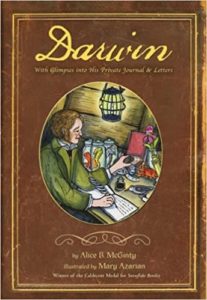
|
Alice McGinty’s picture-book biography Darwin (Houghton Mifflin Books for Children, 2009), illustrated with terrific tinted woodcuts by Mary Azarian, intersperses a reader-friendly text with hand-written excerpts from Darwin’s diaries and letters. For ages 7-11. |
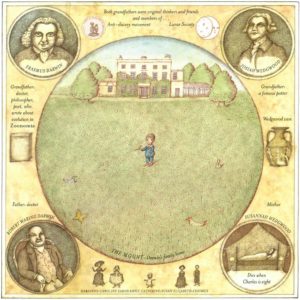
|
Peter Sis’s spectacularly illustrated The Tree of Life: Charles Darwin (Farrar, Straus & Giroux, 2003) is a fascinating overview of Darwin’s life and work, creatively illustrated with journal pages, picture cards, charts, maps, portraits, sketches, and diagrams. For ages 8 and up. |
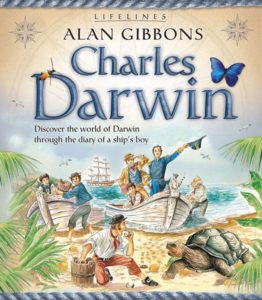
|
By Alan Gibbons, Lifelines: Charles Darwin (Kingfisher, 2011) is the story of Darwin’s five-year voyage on the Beagle, as told through the diary of ten-year-old ship’s boy James Kincaid. Later chapters provide general information about the science of Darwin’s time. For ages 8-12. |
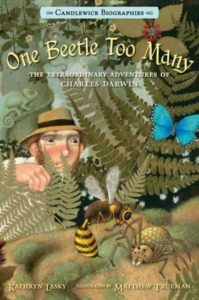
|
Kathryn Lasky’s One Beetle Too Many (Candlewick, 2012) – with humorous and delightful illustrations by Matthew Trueman – is a wonderful portrait of a man of endless curiosity, from his beetle-collecting childhood to his trip around the world on the Beagle (collecting all the way). Ultimately his fascination with biology and geology led to the theory of evolution. The book is sprinkled with quotes from Darwin’s own writings. For ages 8-12. |
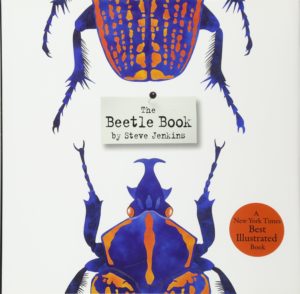
|
Incredible beetles! Steve Jenkins’s irresistible The Beetle Book (Houghton Mifflin Books for Children, 2012) shows just why Darwin was so hooked. Learn about jewel beetles, tortoise beetles, giraffe beetles, forest fire beetles, and beetles that stink, glow, squeak, and walk on water. One out of every four living things on earth is…a beetle. For ages 7 and up. |
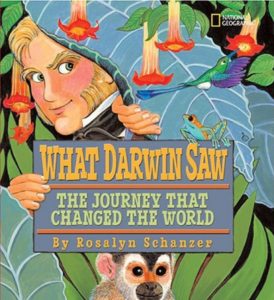
|
Rosalyn Schanzer’s What Darwin Saw: The Journey That Changed the World (National Georgraphic Children’s Books, 2009) is a graphic-style account of the landmark voyage of the Beagle, with colorful and information-packed panels and conversation bubbles incorporating many of Darwin’s own words from his journals. Bright cartoons combined with sound science for ages 8-12. |
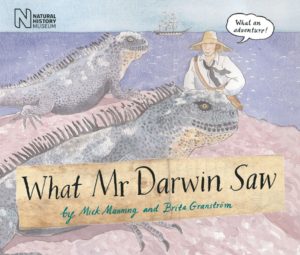
|
By Mick Manning and Brita Granstrom, What Mr. Darwin Saw (Frances Lincoln Children’s Books, 2009) – told in the first person – is the picture-book story of Darwin’s life from childhood through the publication of On the Origin of Species. Conversational cartoon bubbles provide humorous asides; and illustrations light on some of the history-is-gross aspects of Darwin’s career: Darwin, sick (“Blugh”), dashes from the room at the side of a blood-spewing amputation; Darwin with a mouthful of huge beetles; Darwin seasick on the Beagle. While memorable, this may not be every kid’s cup of tea. For ages 8-12. |
|
|
Jay Hosler’s 150-page The Sandwalk Adventures: An Adventure in Evolution Told in Five Chapters (Active Synapse, 2003) is a graphic-novel explanation of evolution with a quirky back story: Mara and Willy, a pair of mites living in Darwin’s eyebrow, are convinced that Darwin himself (“Flycatcher”) is a god and the creator of all mites. Darwin, attempting to convince them that this is not true, describes his discoveries and explains the theory of evolution. The mites’ creation myth provides a means for contrasting religion and science. For ages 9 and up. |
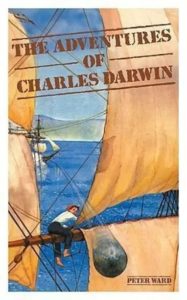
|
Peter Ward’s short chapter book The Adventures of Charles Darwin (Cambridge University Press, 1986) is the story of Darwin’s work from the slightly astonished but impressed perspective of George Carter, the young cabin boy on the Beagle. For ages 9-12. |
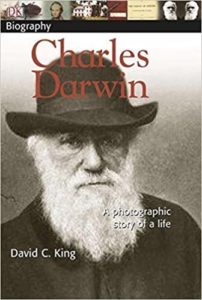
|
In the DK Biography Series, David C. King’s 128-page Charles Darwin (Dorling Kindersley, 2006) is a well-done chapter biography, filled with interesting details and illustrated with color photographs and period reproductions. For ages 10 and up. |
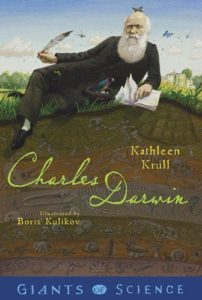
|
In the Giants of Science Series, Kathleen Krull’s Charles Darwin (Viking Juvenile Books, 2010) is a gem. This 144-page chapter book covers Darwin’s life and work – but with pizzazz, scientific acumen, and a wealth of human interest. A delightful and informational read for ages 10 and up. |
| For more on Kathleen Krull’s Giants of Science Series, which includes terrific biographies of Leonardo da Vinci, Albert Einstein, Isaac Newton, and Marie Curie (and more), see Kathleen Krull: Giants of Science. | |
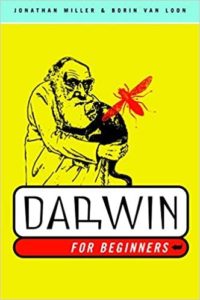
|
Jonathan Miller and Borin Van Loon’s Darwin for Beginners (Pantheon Books, 2003) is a graphic-style history of evolutionary theory, illustrated with clever pen-and-ink cartoons. The book covers Darwin’s personal history, the studies that led up to his famous theory of evolution, his supporters and opponents, and subsequent research that expanded upon and clarified Darwin’s work. For ages 13 and up. |
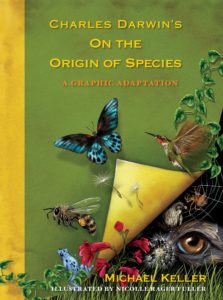
|
Charles Darwin’s On the Origin of Species (1859) – one of the most important scientific works of all time – is not an easy read. (College biology majors, compelled to slog through it, often whine.) Michael Keller’s Charles Darwin’s On the Origin of Species: A Graphic Adaptation (Rodale Books, 2009), illustrated by Nicolle Rager Fuller, is, on the other hand, not only far more accessible, but visually stunning. Framed in the context of Darwin’s life, the book includes biographical information, scientific explanations of the research leading to his evolutionary theory, and an “Afterward,” in which Darwin’s work is linked to later discoveries, such as the principles of Mendelian inheritance, the elucidation of the structure of DNA, and the mapping of the human genome. For ages 14 and up. |
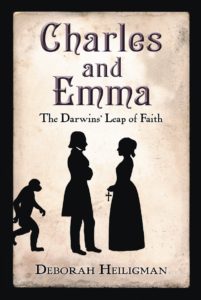
|
Deborah Heligman’s Charles and Emma (Square Fish, 2011) is the story of Darwin’s marriage to his cousin, Emma Wedgewood, covering both Charles and Emma’s life together and the way in which they coped with their differing philosophies. Emma was devoutly religious; Charles, a scientist, put his faith in reason. Illustrated with period photographs. For ages 12 and up. |
|
|
By A.J. Wood and Clint Twist, Charles Darwin and the Beagle Adventure (Templar, 2009) is a marvelously designed scrapbook-style account of Darwin’s landmark voyage, filled with maps, fold-outs, booklets, letters in envelopes, faux photographs, drawings, diagams, and handwritten excerpts from Darwin’s journals. For all ages. |
| At Neatorama’s 10 Fun Facts About Darwin, readers discover, for example, that Darwin once ate an owl. | |
| From the December 2005 issue of Smithsonian magazine, Frank Sulloway’s The Evolution of Charles Darwin discusses Darwin’s discoveries on the Galapagos Islands and traces the changes in his thinking, from creationist to evolutionary biologist. | |
| From the Victorian Web, Charles Darwin has information and resources related to Darwin’s place in Victorian social, political cultural, religious, and scientific history. | |
| The Home of Charles Darwin website has views of Down House, where Darwin lived, worked, and wrote On the Origin of Species, historical background information, a plan of the house, and a timeline. |

